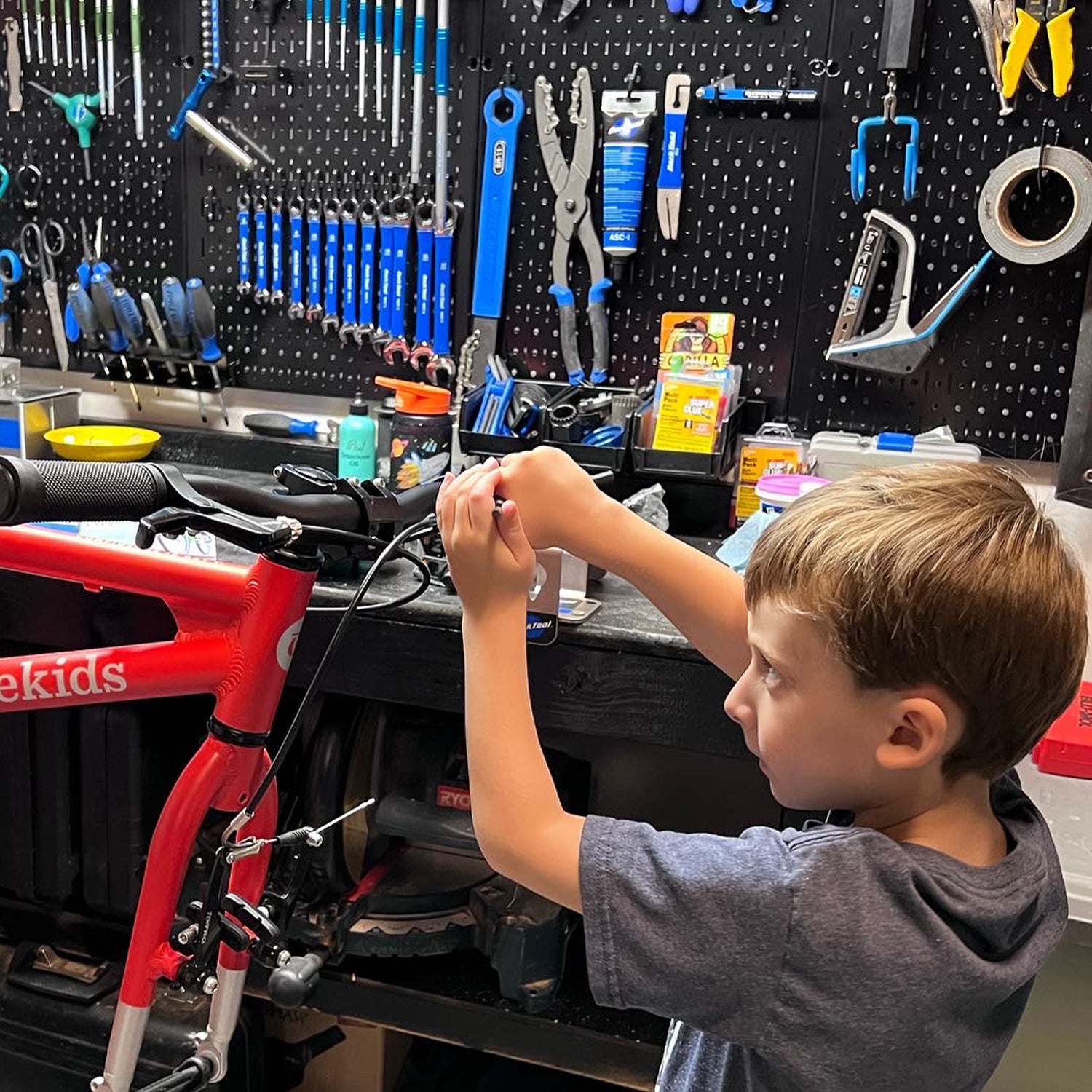When it comes to bicycles and components, people tend to defend their preferences with what amounts to an almost-religious fervor. But ultimately our opinions about what’s “best” are often just that—opinions. The insufferable retrogrouch insists that steel is the only material worth considering, while the performance-obsessed racer maintains that, gram for gram, nothing beats carbon fiber, and ultimately they’re both right in their own way. Then there are all the parts you can bolt to them: from stem to stern you’ll get a thousand recommendations on which components to use, and unless you’ve got uncommon fortitude you’ll probably find yourself burnt out on bike setup tips before you even get past the handlebars. It’s all enough to make you decide, “Fuck it, I’m leasing a Hyundai.”
But what if you’re not worried about what’s “best,” whatever that means? What if your goal is to build yourself a future-proof bicycle? Something simple and cheap to maintain, and that you can ride and enjoy more or less indefinitely so you’ll never have to listen to any of this crap again? Well here’s your step-by-step guide to building a future-proof bike that will last you (almost) forever.
The Frame
If you ask the question “Which frame material should I choose?” the answers may send you running for the hills. You’re about as likely to get a measured, impartial answer to that one as you are to the question, “Which presidential candidate should I vote for?”
Nevertheless, at least there is an easy answer to the frame question: steel. No, I’m not saying materials like carbon fiber are bad—well, not this time, anyway. There are valid reasons to pick almost every frame material, with the exception of, I dunno, glass or ice.
Still, we’re not talking about which one is lighter, or stronger, or faster, or even more comfortable. We’re talking about a future-proof bicycle here, and here’s why you want steel for that:
Over time, standards change—especially axle widths, which keep getting wider, and steel is the only material that really doesn’t care what size axle you cram in there. I have a 40-ish year-old steel road bike frame, which would have been designed to accommodate a 126mm rear axle. In my time with it I’ve used everything from 120mm to 130mm in there with no problems, and I doubt very much the frame would care if I took it up to 135mm or even beyond. This means I can potentially choose pretty much any hub made in the past century, which means if I need a new wheel I can spend a thousand dollars on something new and modern or I can pick up a used one for $40 on Craigslist without worrying too much about the dimensions. No other material offers this amount of versatility. Plus, you can pick up a 40-ish year-old steel road frame yourself for a couple hundred bucks and confidently (and cheaply!) ride it for another 40 years.
Of course, you don’t need to choose a road frame: hybrid frames, mountain frames, cyclocross frames, even those newfangled “gravel” frames all make good candidates. But an older road bike frame in particular will also have additional attributes that make it a great candidate for a future-proof bicycle. These include:
- A threaded bottom bracket shell, which means you can use anything from the loose-ball square-taper bottom brackets of yesteryear to the outboard bottom brackets of today.
- A threaded fork, which means you can use a quill stem and easily futz with your bar height for all eternity as you become less and less flexible—or convert to a threadless fork if you’d rather, which is a relatively straightforward operation, even with a one-inch headtube.
- Caliper rim brakes—like steel, I’m not saying they’re better (at least not this time), but old-fashioned sidepulls (dual- or single-pivot) are cheap, effective, so simple as to be idiot-proof, and you’ve got decades upon decades of inventory to choose from
- Horizontal dropouts—yes, a vertical dropout is more secure, but a horizontal dropout lends versatility in that it even allows you go single-speed should the need or desire arise. Also, you know those ? Horizontal dropouts are the original flip chip.
- Clearance—road bike designers didn’t come up with the idea that road bikes should have limited tire clearance until somewhere around the 1990s. That means you can generally fit 28mm tires easily and even go wider in many cases on those older steel road frames.
Also, remember: there’s no rule that you have to use drop bars on a road bike frame. You can turn an older steel road frame into anything from a full-on race bike to an upright urban commuter.
The Wheels
Forget the “wheel systems” with proprietary rims, hubs, and spokes. Whether you buy them already built or you customize them yourself, you want a traditional pair of wheels with 32 or 36 steel spokes. This means if a spoke breaks you can just install a new one—and you can keep riding in the meantime, since you’ve got 31 (or 35) more. This also means you can keep your hubs and even sometimes your spokes should you need to replace your rim due to wear, damage, or changing needs. There’s nothing stopping you from swapping in wider rims, or tubeless rims, or even carbon rims if that’s what you’re into. As for the hub, you want a Shimano-compatible spline pattern, and better yet an actual Shimano hub. Cartridge bearings are generally used as a selling point when it comes to hubs, but those are for skateboard wheels, and nothing beats good quality cup-and-cone bearings for smoothness and serviceability. Also, a Shimano hub will let you use like 30 years’ worth of cassettes, from 7-speed up to as high as 12 speeds depending on the vintage of the hub; plus the freehub bodies are not only replaceable, but in lots of cases they’re even interchangeable, which means you can keep the hub going practically forever. Also, you want a Hyperglide hub, not the newer “Micro Spline” stuff. Given how long Hyperglide has been around, parts for it shouldn’t be disappearing anytime soon.
The Drivetrain
As far as shifting, for maximum future-proofing, you want the oldest system there is: friction. Shimano derailleur? Campagnolo? 5 speeds? 10 speeds? 20 speeds? (Okay, 20 speeds is not a thing…yet.) Pretty much anything will work with a friction setup, giving you virtually unlimited access to decades upon decades’ worth of cassettes and other consumables.
Okay, fine, frictions not for you. Go with indexed downtube shifters, or bar-end shifters, or thumbshifters. Or, by all means, go “modern” with the convenience of integrated shifters such as Shimano STI or SRAM DoubleTap. (Or of course Campagnolo Ergo, but once you commit to indexed, integrated shifters you start getting locked into manufacturers’ proprietary parts, and Campagnolo can make using more widely available Shimano drivetrain stuff a bit more difficult.) Just keep in mind that indexing requires you to match your drivetrain components more carefully, though given the abundance of components out there this isn’t much of a problem.
And whatever you do, go mechanical. I mean, nothing’s really stopping you from putting electronic shifting on that old steel frame, but if you’re going for future-proof above all else nothing beats the simplicity of levers and cables, and even if mechanical shifting is disappearing from the high end of component makers’ offerings it’s unlikely to vanish completely within our lifetimes. And again, we’re talking about future-proofedness here, so you want to be able to keep riding through those solar flares and electromagnetic pulses.
So yeah, you want a classic road bike. For sheer versatility and simplicity, nothing beats it. Or lease a Hyundai, whichever works for you.


